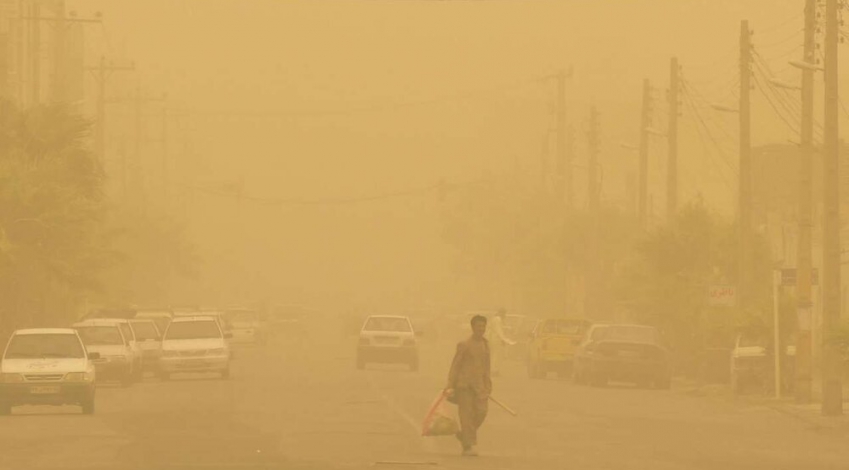Wednesday 31 August 2022 - 22:27
Story Code : 399824
Iran, Iraq, and Syria to start action plan on dealing with SDS
During the early days of the calendar month of Mehr (starting September 23), exchanging expertise between Iran, Iraq, and Syria will start to curb and confront sand and dust storms, IRNA quoted DOE chief Ali Salajeqeh as saying.
In May, an Iranian delegation, headed by Salajeqeh, embarked on a trip to Iraq, Syria, and Kuwait to resolve the problem of sand and dust storms.
Letizia Rossano, the director of APDIM, has said Iran is really at forefront of understanding the problem of sand and dust storms as well as dealing with it.Studies and maps show that Saudi Arabia produces the highest level of particulate matter, followed by Iraq, Syria, Kuwait, and the UAE, respectively, Salajeqeh has said.
�Environmental protection is a comprehensive subject, meaning that if something happens to the environment in a certain point of the world, it will affect other regions elsewhere. The issue of sand and dust storms is the same. Neighboring countries can harm each other as a result of neglecting the environment,� he explained.
To deal with sand and dust storms, positive measures have been taken inside the country, he said, adding that a ten-year plan has been prepared to curb internal sources of sand and dust storms.
Iran is surrounded by 8 large SDS hotspots stretching to 270 million hectares in neighboring and Persian Gulf countries, Ali Mohammad Tahmasebi, head of the national working group for mitigating SDSs, has said.
The SDSs phenomenon has been plaguing the country for several years and has caused problems in many provinces. According to experts, natural and human factors are involved in the occurrence and severity of this phenomenon which is mainly caused by excessive consumption of water and drying up reservoirs.
The internal dust sources are estimated at 34.6 million hectares, generating an average amount of 4.22 million tons of dust per year, about 1.460 million hectares are dried wetlands.
Some 4.23 million tons of dust are raised per year, which means the loss of soil fertility will hit the agricultural sector.
Moreover, 300 million hectares in the neighboring countries are giving rise to SDSs, which transport dust into Iran. The total dust density is estimated at about 150 million tons.
In fact, the dust is raised from Turkmenistan, Uzbekistan, Afghanistan, and Pakistan in the northeast as well as Iraq, Syria, Saudi Arabia, and Jordan in the south, southwest, and west.
In the past four years, about �370 million has been spent by the National Development Fund to combat SDSs, which had good results, but it seems that the annual credit is declining as conditions improve, Tahmasebi said.
On June 12, Tehran played host to a conference of ministers and officials from 11 countries, aiming to boost cooperation for resolving extant environmental problems, especially sand and dust storms.
Environment ministers of Iraq, Armenia, the United Arab Emirates, Oman, Syria, and Qatar, as well as deputy ministers of Azerbaijan and Turkmenistan along with delegations from Turkey and Uzbekistan, participated in the event which was held with the theme of �Environmental Cooperation for a Better Future.�
Addressing the opening ceremony, President Ebrahim Raisi said, �Conservation of the ecosystem and environment, which is a global concern, especially for countries of the region, is an inevitable priority today. If the environment is not safe and peaceful for people, the development will not be in its proper place and it will even become a threat to human health.�
For his part, Salajeqeh said that the issue of the environment is an all-encompassing and cross-border issue that either stabilizes or challenges the life elements.
Unfortunately, environmental hazards have increased significantly today and have affected people's lives across the world, he added.
The creation of a regional environmental organization, a secretariat, and an expert group to follow up on the approvals of the meeting are on the agenda, he stated.
Letizia Rossano, the director of the Asian and Pacific Centre for the Development of Disaster Information Management (APDIM), said on June 8 that Iran is really at forefront of understanding the problem of sand and dust storms as well as dealing with it.
More than 80 percent of the entire populations of Turkmenistan, Pakistan, Uzbekistan, Tajikistan, and the Islamic Republic of Iran are exposed to medium and high levels of poor air quality due to sand and dust storms,� she noted.
By TEHRAN TIMES
# Tags











